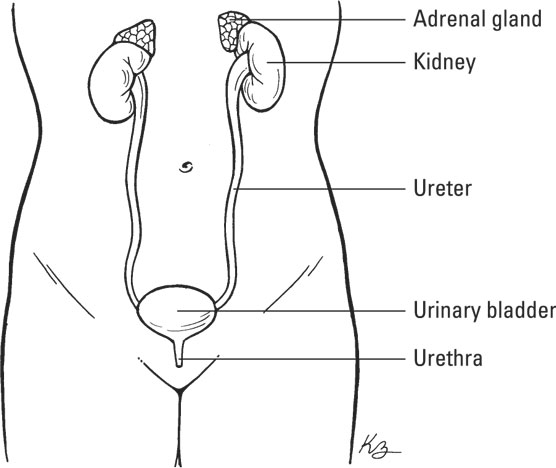So, how does that big steak dinner you ate last night turn into the next morning’s output in the form of urine? Well, food and oxygen combine in cells to produce energy, a process called catabolism. In the process, food and oxygen are not destroyed, but small particles making up the food and oxygen are rearranged in new combinations, and part of the result is waste products. Waste products in the form of gases (carbon dioxide) are removed from the body by exhaling through the lungs. Nitrogenous waste (the by-product of protein food) is more difficult to excrete from the body than gases. This kind of waste is secreted as a soluble dissolved in water, a waste substance called urine. The main function of the urinary system is to remove urea from the bloodstream.
Urea is formed in the liver from ammonia (which is, believe it or not, basically the same stuff you use to clean the kitchen). The bloodstream carries it (in the same manner as hormones and lymph) to the kidneys, where it passes with water, salts, and acids out of the bloodstream into the kidneys. The kidneys remove waste products, producing urine that travels through each ureter into the bladder. Urine is then excreted from the bladder via the urethra. Magically (or so it might seem), your steak dinner has turned into pee!
 Illustration by Kathryn Born
Illustration by Kathryn BornThe urinary system.
Kidneys
You have two kidneys, unless you’ve had one removed. Kidneys are dark reddish brown, bean-shaped organs that are located behind the abdominal cavity on each side of the spine in the lumbar region. They are embedded in a cushion of adipose (fat) tissue and surrounded by connective tissue for support. Each kidney is about the size of a fist and weighs approximately 8 ounces. The left kidney is a little larger and sits a little higher than the right one.Each kidney consists of an outer cortex and an inner medulla region. The cortex contains millions of nephrons, and the medulla contains the collecting tubules (small tubes). A segment on the medial border of each kidney, called the hilum, allows the blood vessels, nerves, and ureter to pass through. The nephron is the kidney’s functional and structural unit, or the “brains” of the kidney. Each is a urine-producing microscopic structure, consisting of a renal corpuscle and renal tubule.
Hilum’s Latin meaning is “a small thing or a trifle.” This is a term for a depression or pit in an organ where vessels and nerves enter.
Glomeruli (singular glomerulus) are clusters of capillaries (small vessels) at the entrance of each nephron. They help filter the blood, beginning the process of urine production. In the blood-filtering process, water and solutes from the blood in the glomeruli pass through the capillaries and the walls that make up the glomeruli into the tubules. Tubules have the ability to remove substances your body needs and return them to the blood.
The Greek word pyelos means “tub-shaped vessel,” which describes the shape of each kidney.
Ureters
You have two ureters (right and left). They are muscular tubes about 15–18 inches long, lined with mucous membrane, extending from the renal pelvis down to the bladder. The left ureter is longer because the left kidney sits higher in position. The urine enters the bladder in spurts via each ureter every 10–30 seconds.At the bladder entrance is a ureteral orifice (opening) that opens to allow urine into the bladder from each ureter. The orifice works in sequence with the peristaltic (wavelike) action that propels the urine through the ureter. This action prevents urine from flowing back into the ureter when the bladder contracts.
Urinary bladder
The urinary bladder is a hollow, very elastic muscular sac in the pelvic cavity. It acts as a temporary reservoir or “holding tank” for urine. It has two openings to receive the urine coming from each ureter. Another opening, the urethra, provides an exit route for the urine out of the body. The trigone is a triangular space at the base of the bladder where the ureters enter the bladder.An average bladder holds more than 250 ml of urine before producing the desire to urinate.
Contraction of the bladder and internal sphincter is an involuntary action, whereas the action of the external sphincter is controlled by you. The act of preventing or concluding voiding (urination) is learned and voluntary in a healthy body.Urethra
The urethra is a membranous tube that carries urine from the bladder to the exterior of the body. The process of expelling or voiding urine is technically called micturition. The external opening of the urethra is the urethral meatus or urinary meatus. The female urethra is about 11/2 inches long, and its only function is urination. In the male, it is approximately 8 inches long. It extends from the bladder neck through the prostate and through the penis. The male urethra carries both urine and reproductive organ secretions. Thanks to Mother Nature, the urethra can’t mix sperm and urine, so it’s difficult to pee with an erection. That sure prevents unwanted embarrassment during those tender moments.Catheter comes from the Greek catheter, meaning “a thing let down.” A catheter lets down urine from the bladder.
Micturate comes from the Latin mictus, which means “a making of water.” From the verb micturate comes the noun micturition. Be sure to note the spelling: Micturition (expelling urine) is often misspelled as micturation.
The p is silent in pneumonia, just as pee is silent in a swimming pool. That’s why you probably should not frequent swim-up bars on vacation. You never know what is lurking in the water.

